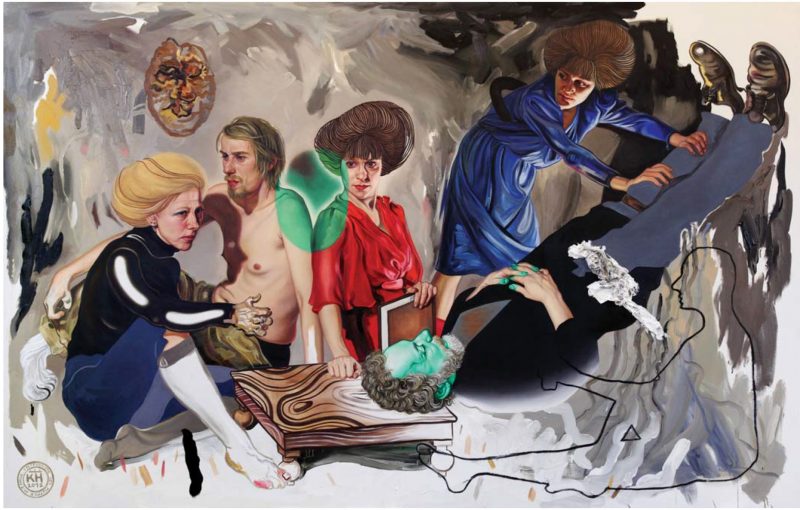Kati Heck was born in 1979 in Dusseldorf and lives in Antwerp with her husband. Though her work encompasses sculptural installation, short film, and photography, she is best known for her large-scale paintings, which hover between the cartoonish and the realistic. There is often a playful, brutish, humorous, grotesque quality to her work. Currently she is preparing for a solo museum exhibition that will appear at the Centro de Arte Contemporáneo in Málaga, Spain, in 2013. We spoke over Skype several times.
—Makeal Flammini
Entführung der Mutter mit Hase

THE BELIEVER: What is happening in this painting?
KATI HECK: This painting involves two evenings and an afternoon. It begins with my friend Jürgen calling to say, “It’s time to pick up the magic mushrooms.” So he, my husband, and two others went to collect them. If you look, you can see in the top left corner there is a drawing of a bus and the four people who went to pick up the mushrooms. I like to give the viewer small things to discover when they come closer to the painting. When they returned they were all so proud, they said they had found the Mother Mushroom, the mushroom that carries twenty times the psychedelic power of all the others. It was really pretty, a green-blue color and quite huge. We were all so impressed. So I hid all of the mushrooms for later.
BLVR: Where and why did you hide them?
KH: In a box in the sleeping room. I was afraid someone would take them, for good reason. One evening our Swedish friends came, which you can see as a turtle and a spider, scratched into the white under where Guy is lying. All the people in the painting came; we had a big dinner, and at the end everyone but myself took all the mushrooms except for the Mother Mushroom. I told them, let’s go to the park nearby, it will be much nicer to enjoy this feeling. So we went, and because my friend and I jog there every day, I know there is this kind of Indian hut.
BLVR: Tepee?
KH: Yes. They were so impressed by this tepee because they thought I had made it for them. There was a child’s playground with a slide, and Guy went down the wrong way, exactly like in the painting. Somehow it seemed to me that if he would go the other way he would go to heaven delivered on a silver platter. It looked like he was dead and being...
You have reached your article limit
Sign up for a digital subscription and continue reading all new issues, plus our entire archives, for just $1.50/month.
Already a subscriber? Sign in




